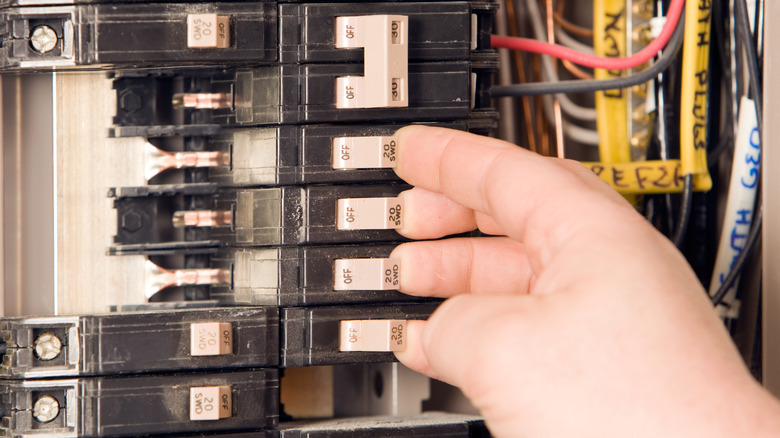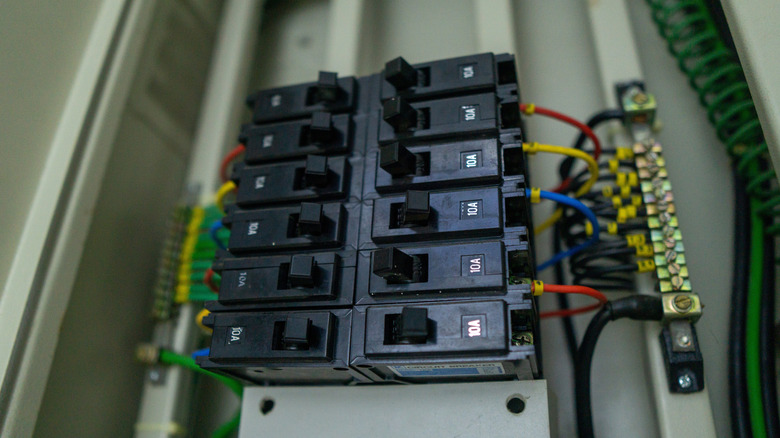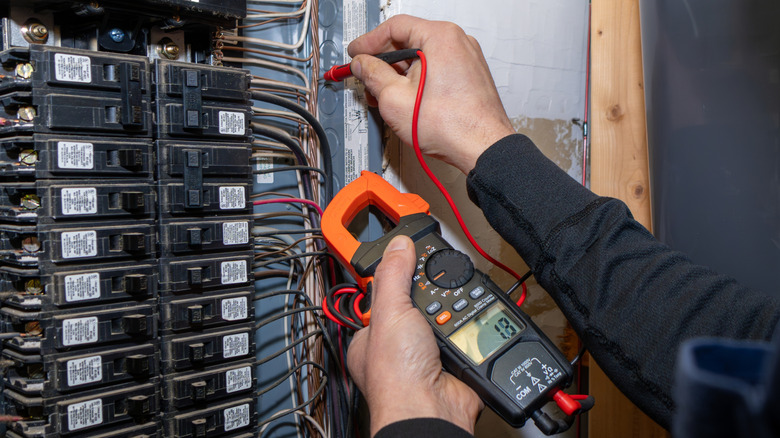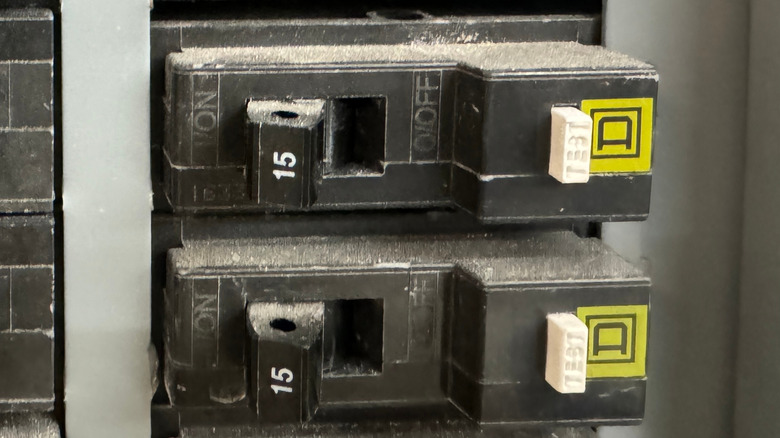Warning Signs That Your Circuit Breaker Is Bad (And How To Fix The Issue)
Circuit breakers can be frustrating. You're happily bopping through your day, perhaps craving an English Muffin, so you decide to plug a toaster oven into the outlet where your refrigerator is plugged in. Maybe some coffee and music too, you think, so you break out the old extension cord and add a coffee maker and your 100-watt stereo to the same outlet. Suddenly, the power goes dead — coffee pot empty, muffin cold, and AC/DC's "High Voltage" evaporating mid-solo. You've tripped the breaker, and it's annoying, though significantly less annoying than the fire you could have started.
When the breaker doesn't trip and the smell of burning plastic overtakes the smell of toasted muffin, you have an immediate problem. When a bad breaker refuses its protection, even the smallest of electrical issues can become life-threatening. Fortunately, there are warning signs of trouble: a burning smell, a hot breaker panel or outlets, frayed or melting wires, scorching in the breaker box, visible corrosion or loose connections in the breaker box, unexplained breaker tripping, and flickering lights. Any signs that produce heat, sparks, or a noise (typically a buzzing or chirping noise coming from your breaker box) require an urgent call to your electrician.
Some of these signs may not indicate a faulty circuit breaker; they are reliable and typically last 30-40 years. Frequent tripping can shorten a breaker's lifespan, however, and a truly defective breaker might only last weeks or months. While you should be on the lookout for any of the signs above, there are more concrete bits of evidence that your breaker can no longer be trusted, and most are easy to check for.
A breaker failing to trip is a serious issue
A circuit breaker that won't trip — that is, won't shut down power when confronted with a ground fault, overcurrent, or overload situation — is probably the scariest scenario since it leaves its circuit unprotected. Your last and best line of defense against electrical fires and electrocution is off the table, and you might not even know it. If you have any reason to think a breaker is not tripping when it should, you're in a tricky (but fortunately very unusual) situation. Diagnosing a breaker problem is one of those electrical projects you shouldn't attempt yourself unless you're a pro. Although a breaker can be tested to ensure it trips properly, a professional is likely to simply replace it if there's even a hint of an issue. If you're determined to test it, the procedure isn't quite as simple as it might seem.
Because some breakers are designed to delay tripping for a period of time inversely related to the amount of overload to avoid nuisance tripping, simply putting too much of a load on a circuit might not work. Pros have access to the relevant data and can perform an inverse-time over-current trip test that takes these delays into account. If you're determined to get to the bottom of it yourself, you can gradually increase the load until you've reached 200% of the circuit's rated ampacity (40 amps for a 20-amp circuit, for example), which breakers typically interpret as a short circuit. Breakers should trip at 130% of the rated load, but without documentation for your breakers, this could take an unknown amount of time to happen.
Breakers that won't reset or trip unnecessarily should be replaced
The opposite problem — a breaker that trips instantly when you reset it, and won't allow power to pass through no matter what you do — is certainly annoying, but far less dangerous. The testing procedure is simple enough, but it can be a little tedious. The first step is to figure out which breaker is suspect and shut it off. Carefully check all outlets that might be tied to it and unplug any devices that you suspect are on that circuit. Shut off all light and fan switches in adjacent areas as well. The goal is to eliminate any device that might use the breaker in question.
Then, reset the breaker by pushing its toggle mechanism to the "on" position. If the breaker trips, double-check that you've eliminated every possible electrical device on that circuit, then repeat the test. If it trips again, there's a chance you have a faulty breaker. It's certainly possible for a knowledgeable and careful homeowner to replace a circuit breaker, but because of the dangers of disassembling and handling components of a breaker box, it's usually best to call in a pro. There might be a hidden explanation for the tripping — some overload situation or short circuit you can't see — and an electrician will have the best handle on (and tools to detect) all of those possibilities.
Wrong (or no) voltage could indicate a faulty breaker
If you are concerned that you're not getting the expected amount of voltage from a circuit breaker — for example, if a breaker does not appear to have been tripped but its circuit seems to have no power — there are a few potential causes. These include faulty wiring in your home's walls or at the first switch, as well as other issues that are best diagnosed by a licensed electrician. If you're concerned about a faulty breaker not letting through the right amount of voltage (or any at all), this is fairly easy to test with a multimeter, if you have one and understand their basic operation. Use extreme caution when poking metal objects like multimeter leads into a circuit breaker box, and call an electrician if you're uncomfortable with any aspect of the procedure.
After you identify the breaker in question, unscrew and remove the metal enclosure cover to expose the breaker's wiring. Switch the breaker in question to the "off" position and set your multimeter to read AC voltage. Touch one lead to the breaker's terminal screw and the other lead to a screw on the breaker panel's ground bar. You should read no voltage. Now, flip the breaker on and re-test the terminals. For a standard household outlet, you should read 110-120 volts. Anything substantially different is an indication of a faulty breaker, and you should replace it promptly.
Testing GFCI, AFCI, and dual-function breakers
These procedures cover most standard-issue circuit breakers, but there are a variety of other breakers that have different testing procedures. The most common of these are AFCI, GFCI, and dual-function (AFCI and GFCI) breakers, which are often required by code and have test buttons built in. The testing process is the same for AFCI, GFCI, and dual-function circuit breakers. Identify the correct breaker and switch it to the "on" position. Depress the test button, which should trip the breaker. Push the toggle to the "off" position, then to the "on" position to reset the breaker. If it doesn't trip when you push the test button, you should replace the faulty breaker as soon as possible.
If you are suspicious of the functioning of an AFCI, GFCI, or dual-function breaker, keep in mind that arc-fault interrupt devices are designed to detect sometimes subtle problems with wiring, and as a result, they can be prone to tripping when there's really no problem. This can be caused by brushed motors on devices like vacuums, or by appliances that take an unusually large amount of power to start up but normally run within the circuit's limits. AFCIs can also detect problems that are invisible to you, such as shared neutral wires and loose terminal connections, which might cause you to suspect a faulty breaker when you're actually dealing with a wiring problem.




